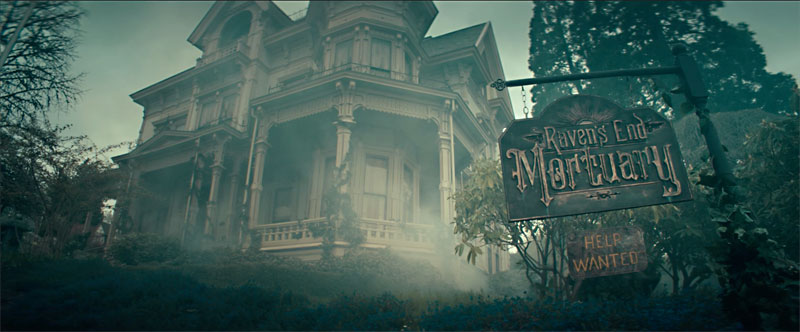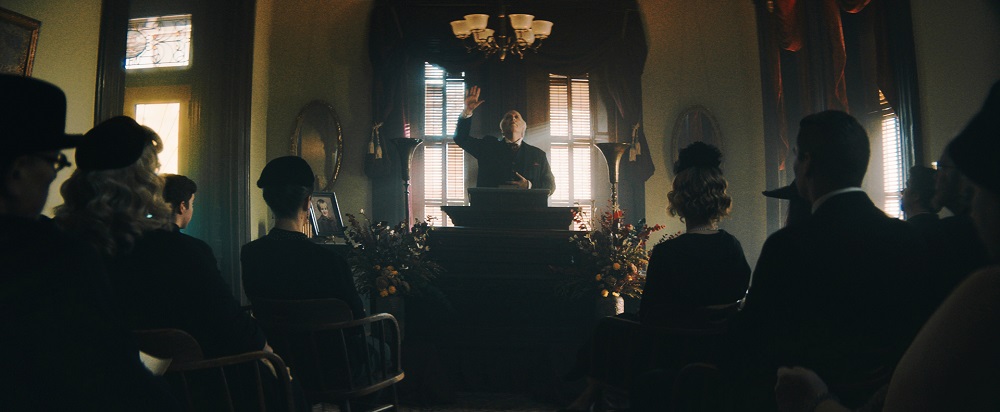Open the Crypt Door to The Mortuary Collection
How two days of filming in Austin saved Ryan Spindell’s horror anthology
By Richard Whittaker, Fri., April 23, 2021

Behind every story, there's always another story. Ryan Spindell's Gothic horror-comedy anthology The Mortuary Collection arrived on Blu-ray this week, a year and a half after it made its Austin premiere at 2019's Fantastic Fest. However, one segment – "The Babysitter Murders" – had already played at Fantastic Fest four years earlier as a standalone short. Add another layer: Within the short, there's a film on the TV in the background, a Seventies slasher flick called The Babysitter Murders. Within that, eagle-eyed Austinites will recognize a veritable who's who of local actors: Josephine McAdam (Tower, Dear Mr. Brody), Kirk Johnson (The Man From Orlando, The Unicorn), Katie Folger (Grow Up, Tony Phillips, Rooster Teeth's Day Five), and, under the slasher's mask, Sam Eidson (Zero Charisma, 68 Kill).
Why are they there? Spindell admits, it's because he got his budget wrong. He crowdfunded the original short, and shot the main story in Los Angeles' Heritage Square, an open-air architecture museum in historic Montecito Heights. However, when it came time to shoot the movie inside the movie, he realized that he'd spent nearly all his budget on the rest of the short. "I went, 'Well, there's no way I can make a fake 1970s slasher movie in Los Angeles for two thousand bucks."
However, those scenes were pivotal to the story, so he had to shoot them. His solution? Go somewhere where $2,000 goes a lot further, and so he reached out to some friends he had in the Austin area. Enter Austin filmmaking couple Joe Nicolosi and Stephanie Noone, who Spindell had met at the Stanley Film Festival. They bonded as short filmmakers, and were among the first people Spindell called when he needed help. "I went, 'Do you guys think you can help pull something off? I have two thousand bucks and ...' 'Yeah, sure, no problem.' I was like, 'No, wait let me get ...' 'No, no problem, we'll do it.'" He flew to Austin, and they'd put together all the pieces for a two-day shoot. "We honestly shot on a nicer camera than we shot the rest of it on," said Spindell.
"This indie 'let's get together and make something special' spirit is why I got into film in the first place," he added, "but it's something that's trickier to find in Los Angeles." By decamping to Texas, "for two days I got to shoot with the best of the best in Austin on this little weird project [and] I was honestly so sad to leave."
Looking back, he credits that experience as doing more than just adding "this unique and colorful piece of filmmaking that I never would have been able to pull off on my own. It's also a testament to the power of in- person film festivals. He said, "I mentor kids who are graduating film school, and I always say, 'Go to as many festivals as you can. Meet your peers, because these are the people who are going to help you.'"
Austin Chronicle: The original short has this glorious, mid-century feel to it, and that’s where this sense of mid-Century Americana about Raven’s End comes from. What were the challenges of tying the short into the overall look and feel of the feature?
Ryan Spindell: It’s two things. First, the whole thing was originally conceived and written as a feature film, so I had a very strong sense of what it would look like from story to story, and I put a decent amount of work into making sure that there was evolution within the stories, how the stories connected, and how the movie felt like as a whole. So it started out with a pretty strong aesthetic concept.
The way that we did the rest is that we made the rest of the movie the same way we made the short, because we didn’t have enough money to make the movie in a traditional way. When we first got this piece of money to the movie, we met with the three line producers and they said, ‘There’s no way you can make this movie for less than four times what you have for a budget, and even then it’s going to be a bad version of what you want to do. You’ll have to trim the script way down.” We couldn’t understand that, because we had just made “The Babysitter Murders” for $50,000, which is a huge budget for a short. For the feature we were like, “Oh, we have five times, ten times that much money, we should be able to pull it off.”
So, instead of doing a traditional movie, we did it piece by piece, over nights and weekends, over two years. It’s a grueling process, both physically and emotionally, but it did allow us to put in the time and energy into the details, to make it feel like a really robust thing. “We want to have a mural in the wall with a crack in. OK, we don’t have ten thousand dollars to afford an expert muralist, but we can get my friend who’s a comic book artist to do it for free.” Some of the puppet shots and a bunch of the inserts, we just shot in my living room. We’d build a little bit of the set, we’d use whatever camera we could find, and we’d piece it together, bit by bit. I think, given that’s the way we shot the short, it gives it this unified feeling that relies on a certain look, style, and level of detail that I don’t think we would ever have been able to pull off with a traditional structure – unless we had a ten to fifteen million studio budget.
AC: That mid-century Americana feel, of baseball card in bike spokes, means you can have this crossover between the Victoriana of Montgomery Dark (Clancy Brown) and the seventies final girl vibe represented by Sam, and it also makes the gore more shocking because it’s not what you expect from that look and era.
RS: It’s almost like Norman Rockwell. My dad has a collection of Norman Rockwell commemorative plates that I was always fascinated by. There’s a level of innocence to at least that perception of that period, of this idealistic, candy-coated version of the world. I always felt like because Things evolved very slowly until that time point, and from then onwards things change dramatically every year.
I think, just because I’m a kid of the Eighties and the Nineties, that 1950s aesthetic is exactly what I got to when I think “timeless.” For me, it was about trying to create this feeling for the overall world, so that these stories aren’t set in any real time and place, and just work as stories.

AC: You also got very luck casting Caitlin Fisher in the original short, because you had an actress who could go toe-to-toe with Clancy Brown in the feature.
RS: I got lucky with a lot of the casting, there wasn’t one dud in the bunch. And to be honest, one of the things that you would do when you’re making your first feature is keep it small, make the cast tiny, and keep the locations limited. Somehow, I decided to make this massive, unwieldy thing with a huge cast, and all these locations. So I really pushed myself into a corner with it, and I was thinking the other day how fortunate I was to have the cast in all the stories. I mean, Christine [Kilmer], the girl in the first story, she has one line of dialogue and she has a three-act story. Or Sarah Hay in the third story, who doesn’t have one line of dialogue, and just has to be comatose and yet empathetic.
Caitlin, she was a wild swing on the short. She was recommended by a friend. Initially I was, ‘I don’t know about her. She looks too innocent and sweet.’ As soon as I met her, I realized she genuinely is innocent and sweet, but she has these layers that were just phenomenal to see her go from this almost cherub-ish blonde girl on the couch to battling with a hammer in the kitchen. The places she was able to go, I had no worries that she would be able to go toe-to-toe with Clancy - who is a gift from the heavens bestowed upon anybody who gets him in their movie.
AC: Clancy’s so perfect as Dark. Was it always going to be him?
RS: Clancy was it. I had a very short list of actors who are character actors. And I don’t mean character actors in the derogatory form. I think character actors are some of the most gifted and wonderful actors that are working out there, but they are always relegated to second fiddle.
I started off with my favorite character actors – Clancy being one of them, of course – and I said to myself, “Who can aesthetically carry this looming, Lurch-ish figure within this fantastical world, but still bring a glimmer of humanity?” That’s what Clancy is so good at. Even when he’s bringing the biggest villain on-screen, there’s this flicker of humanity that you can’t help but grab on to.
The Mortuary Collection is available now on Blu-ray, VOD, and via horror streaming site Shudder. Read our review.








